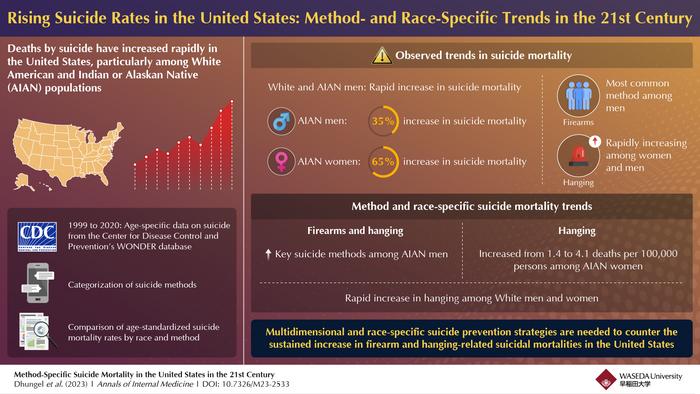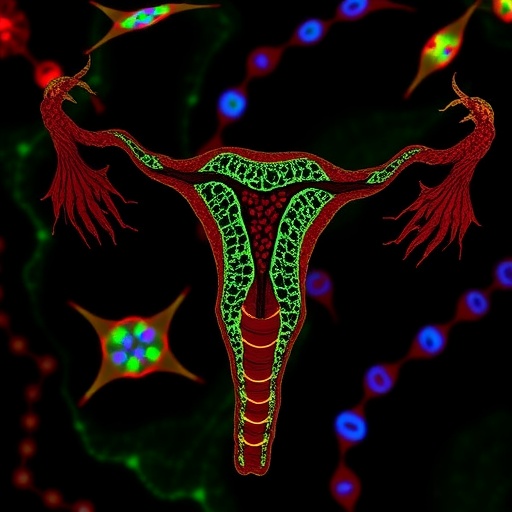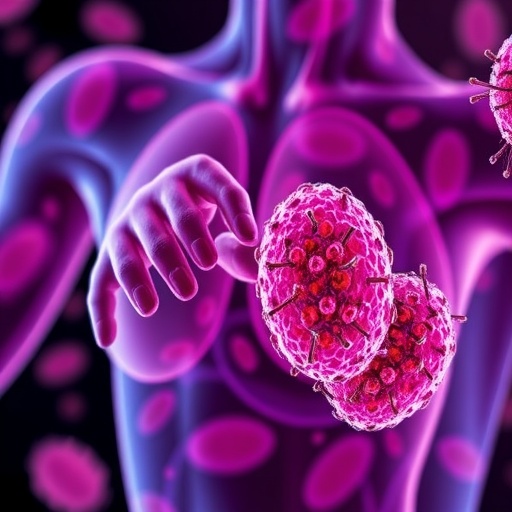Are there specific communities that bear the brunt of suicide mortality? Certain studies have revealed that historically marginalized and economically deprived indigenous populations are linked with higher rates of cluster suicides—especially in Canada, the United States, and Australia. Public health officials need to consider that the risk of suicide contagion—social transmission due to insufficient interventions and resources—is real and must be countered. Now, a consortium of public health experts from Japan, Australia, and China have analyzed trends in suicide mortality in American Indian or Alaskan Native (AIAN) populations, while exploring health inequality among vulnerable populations. The team, led by Assistant Professor Bibha Dhungel from the School of International Liberal Studies, Waseda University, including co-authors Dr. Fiona Shand, Associate Professor, University of New South Wales, Australia, Dr. Jinghua Li, Associate Professor, Sun Yat-sen University, China, and Dr. Stuart Gilmour, Professor, St. Luke’s International University, Japan, published their findings in the Annals of Internal Medicine on December 19, 2023.“In contrast to global suicide rates which decreased by nearly a third between 1990 and 2016, those in the United States saw a rapid increase. ” explains Dr. Dhungel. She further added, “We wanted to study these trends over time in the hopes of distilling underlying patterns specific to sex and the method of suicide.” Studies have reported that the life expectancy of AIAN individuals is seven years less than that of the White population.

Credit: A/Prof. Bibha Dhungel from Waseda University
Are there specific communities that bear the brunt of suicide mortality? Certain studies have revealed that historically marginalized and economically deprived indigenous populations are linked with higher rates of cluster suicides—especially in Canada, the United States, and Australia. Public health officials need to consider that the risk of suicide contagion—social transmission due to insufficient interventions and resources—is real and must be countered. Now, a consortium of public health experts from Japan, Australia, and China have analyzed trends in suicide mortality in American Indian or Alaskan Native (AIAN) populations, while exploring health inequality among vulnerable populations. The team, led by Assistant Professor Bibha Dhungel from the School of International Liberal Studies, Waseda University, including co-authors Dr. Fiona Shand, Associate Professor, University of New South Wales, Australia, Dr. Jinghua Li, Associate Professor, Sun Yat-sen University, China, and Dr. Stuart Gilmour, Professor, St. Luke’s International University, Japan, published their findings in the Annals of Internal Medicine on December 19, 2023.“In contrast to global suicide rates which decreased by nearly a third between 1990 and 2016, those in the United States saw a rapid increase. ” explains Dr. Dhungel. She further added, “We wanted to study these trends over time in the hopes of distilling underlying patterns specific to sex and the method of suicide.” Studies have reported that the life expectancy of AIAN individuals is seven years less than that of the White population.
The team examined age-specific data on self-harm from the Centers for Disease Control and Prevention’s WONDER database over the study period. They profiled suicides by poisoning, hanging, firearms, jumping from high places, and other methods and compared mortality rates per 100,000 persons by method and race for both sexes. Suicide methods were classified using the 10th Edition of the International Classification of Diseases. Dr. Dhungel notes, “Suicide mortality rates among White and AIAN men increased rapidly between 1999 and 2020. The highest rates were observed among White individuals, followed by AIAN populations. Furthermore, the relative increase in rates since 2000 among AIAN men and women was 35% and 65%, respectively. In fact, suicide by firearm and hanging was prevalent among AIAN men, and suicide by hanging increased by nearly 200% among AIAN women.”
Furthermore, the team believes that these trends reflect the historical trauma and that ongoing inequality and discrimination contribute to the high suicide rates in AIAN people, potentially rendering AIAN communities more vulnerable to mental health issues. The study underscores the imperative to address mental health in vulnerable populations and equip clinicians to identify high-risk groups associated with various suicide methods
Dr. Dhungel concludes, “By implementing comprehensive and focused community-based suicide prevention strategies that are racially relevant, communities can work towards a more inclusive approach to suicide prevention. The goal is to reduce suicide rates by addressing the specific needs and challenges faced by different racial groups, ultimately fostering mental well-being and resilience across diverse populations.”
***
Reference
Authors: Bibha Dhungel1, Fiona Shand2, Phuong Nguyen3, Yijing Wang4, Sayuri Fujita-Imazu5, July Khin Maung Soe5, Jinzhao Xie6, Xinran Wang6, Jinghua Li7, Stuart Gilmour8
Title of original paper: Method-Specific Suicide Mortality in the United States in the 21st Century
Journal: Annals of Internal Medicine
DOI: https://doi.org/10.7326/M23-2533
Affiliations
1School of International Liberal Studies, Waseda University, and Department of Health Policy, National Center for Child Health and Development, Tokyo, Japan
2The Black Dog Institute, University of New South Wales, Randwick, New South Wales, Australia
3Graduate School of Public Health, St. Luke’s International University, and Division of Surveillance and Policy Evaluation, National Cancer Center Institute for Cancer Control, Tokyo, Japan
4Shenzhen Center for Disease Control and Prevention, Shenzhen, China
5Graduate School of Public Health, St. Luke’s International
University, Tokyo, Japan
6School of Public Health, Sun Yat-sen University, Guangzhou,
China
7School of Public Health and Sun Yat-sen Global Health Institute, Institute of State Governance, Sun Yat-sen University, Guangzhou, China
8Graduate School of Public Health, St. Luke’s International University, Tokyo, Japan
About Waseda University
Located in the heart of Tokyo, Waseda University is a leading private research university that has long been dedicated to academic excellence, innovative research, and civic engagement at both the local and global levels since 1882. The University has produced many changemakers in its history, including nine prime ministers and many leaders in business, science and technology, literature, sports, and film. Waseda has strong collaborations with overseas research institutions and is committed to advancing cutting-edge research and developing leaders who can contribute to the resolution of complex, global social issues. The University has set a target of achieving a zero-carbon campus by 2032, in line with the Sustainable Development Goals (SDGs) adopted by the United Nations in 2015.
To learn more about Waseda University, visit https://www.waseda.jp/top/en
About Dr Bibha Dhungel from Waseda University
Assistant Professor Bibha Dhungel is affiliated with the School of International Liberal Studies at Waseda University and holds a Doctor of Public Health Degree from St. Luke’s International University. She completed the Global Tobacco Control Program at the Johns Hopkins Bloomberg School of Public Health. Dr. Dhungel has played vital roles in cancer screening and tobacco control projects, and her work spans various areas of health. Trained in epidemiology and biostatistics, her research interests focus on the analysis of mental health issues and non-communicable diseases. She is currently working as a joint researcher at the National Center for Child Health and Development and serves as a Review Editor for Public Mental Health and Life-Course Epidemiology and Social Inequalities in Health sections of the Frontiers in Public Health journal.
Journal
Annals of Internal Medicine
DOI
10.7326/M23-2533
Method of Research
Data/statistical analysis
Subject of Research
People
Article Title
Method-Specific Suicide Mortality in the United States in the 21st Century
Article Publication Date
19-Dec-2023
COI Statement
Disclosures can be viewed at https://rmed.acponline.org/authors/icmje/ConflictOfInterestForms.do?msNum=M23-2533




